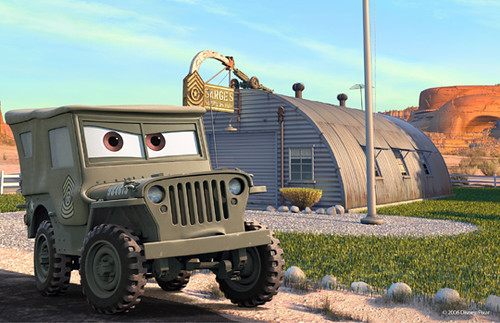
Army / Navy Surplus Stores and StoriesMilitary Vehicle Surplus Sales - Yards & Dealers
Brian's Military Jeeps of WWII - Surplus WWII Jeep parts & Accessories
Speaking of Army Surplus... What about those $50 Jeep in a Crate Stories?
Military Surplus - Remembering what it used to be like
Army / Navy Surplus Stores
| Often noted for their low prices, an "Army Surplus Store' or "Navy Surplus Store" is a retail store that sells surplus military and/or surplus industrial inventory. Military surplus are goods, equipment, clothing and other items, that the governments military branches found to be in excess to their actual needs. These surplus items were sold at public auction by the government when no longer needed by the military. Entrepreneurs would then buy these goods cheaply and then resell them at surplus stores after a slight markup. The surplus was almost always military, government or industrial excess (although now some items are being produced in China specially for the 'Army Surplus' trade, since the real US Military surplus has been almost entirely sold out for several years). Surplus stores sell items such as clothing, jackets, helmets, canvas packs and pouches, and general equipment that was intended for the various branches of the military, but that the military never got around to using in many cases. Usually the goods sold by the military at the government auctions are clothing, equipment, tools, and hardware of a generally useful nature. Only very rarely does a Government Surplus Auction include weapons, ammunition, or vehicles. (For more info on buying Government Surplus Jeeps, there is a link at the bottom). In spite of that, guns and ammo are often found at surplus stores. Sometimes the items being sold in the Army Surplus Store are in used condition and other times the items are NOS - New Old Stock - meaning the item was purchased new, stored, but never used by the military. Many items are in new condition because the item is no longer needed by the military as the technology of warfare makes older versions become obsolete. Surplus stores may also sell items that are past their use-by date but are still usable. Surplus stores often sell hiking, backpacking, and camping equipment as well as survival supplies. |
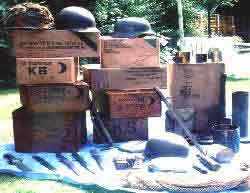
Helmets, K-Rations, C-Rations, mess kits, bayonets, camouflage nets. These were the kinds of things you could commonly buy in the 1960's and 1970's at Army / Navy Surplus stores in the US. You got to experience that wonderful musty smell for free. ;-) |
The world of military surplus has changed. Gone
are the days when every town had an Army / Navy Surplus Store. A typical
refrain in the 1960's & 1970's was "Tell mom I'm heading off to the
army surplus store to get some stuff". Hours later you'd return with bags
of goodies. Some made of stinky canvas - a special smell to many - other
stuff covered in a wax like grease called Cosmoline.
Ahhh, those were the days. There were some great places like Western
Surplus in Los Angeles, and Long Beach Surplus on Garden Grove Blvd.
in Westminster, CA. These places had bins & bins full of ammo pouches,
pistol belts, canteens and shovel covers umm I mean "Entrenching Tool"
covers, and the bins measured about 2 ft x 2 ft x 3 ft deep. Each item
had it own huge bin, which was full to the brim & spilling out onto
the floor. All with prices tagged, penciled or inked (not good) on
to them. Prices like 39 cents, 75 cents, with the expensive ones going
for $1.50 each - even at those prices, I didn't think they could ever run
out. There were just too many bins full of NOS WWI & WWII dated Army
Surplus for them to ever run out - or so I thought. After 10 great years
of always being able to run down to Long Beach Surplus and pick up as many
more as I wanted, I arrived one day to find several bins empty, and most
others seriously depleted. "What happened to all the stuff"? "Some
dealers from Belgium came in last week and cleaned us out of most of our
WWII stuff" I was told by a long time employee. "What?" Why would
THEY be coming over here - way over here on the West Coast, don't they
have this stuff at home? Didn't we leave boatloads of it on the docks when
we sent the troops home after the war ended? Isn't the East Coast closer
to them? What's the deal? This was taking place in the
heyday of faxing. The world was becoming a smaller place. (As a side note...
remember when you used to get jokes FAXED to you instead of being fwd,
and fwd by email? Too funny huh. When was the last time anyone faxed
you a joke or cartoon LOL). The long & the short of it was that
things were drying up. More people were wanting it, and with faxing helping
to put surplus operators, buyers, and middlemen in contact with each other,
it was disappearing fast! I sure wish I had bought & put away
more of it. I also wish I had taken pictures.
|
|||
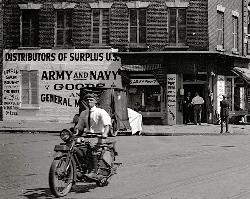
Old Army Navy Surplus Storefront King Street, Alexandria, VA, 1921
|
Brian,
I grew up in Queens, NY back in the 70s & 80's and I used to work for a guy named Sam who owned Woodhaven Surplus. I worked there from October 1983 to February of 1992 when I moved. It was the typical Mil-Surp shop where everything seemed to be in heaping piles with "pig paths" winding through it. There was one light bulb hanging from the ceiling to light the place (or so it seemed). I remember when Philippe (that Belgian guy who was referenced in a post on your surplus stores page) showed up. He played like he was a small time but I don't think Sam really knew how much money 'ol Phil had backing him up. Sam made the mistake of taking Philippe with him and showing him where all of his sources of supply where located. Philippe returned later and simply brought all of those places out. There was another guy who came over from Europe around the same time and did the same thing. He was an Englishman who lived in Belgium. Don't remember his name, though. This was around 1985/1988. I guess when the finished with the East Coast, they just moved out to the West Coast where you were. One reason for these European dealers coming over to the states and buying up all our goodies was that they were able to get current pricing on GI stuff 20 yeas ago. For example; back in 1985, an M41 field jacket sold for $25.00 over here. You could get $75.00 to $125.00 for the same jacket overseas. It was fun to take a few min and reminisce about the good old days with you. They certainly are gone for good aren't there? Regards, Matt Hi Matt, that was an awesome letter! Thanks for taking the time to write it. I totally remember Sam's Woodhaven Surplus. His newspaper style catalogs were huge! They were great. I loved getting them and pouring over them and circling all the goodies I wanted to put in my next order. I wish I had bought twice as much as I did. His store was another case of me thinking he would never run out of his piles of surplus goods. The info in your letter sure corroborates my memory of those days and fills in some of the missing details. Yes, the surplus days are gone. In many case the "real' surplus isn't sold because the Gov. destroys almost everything now so that Al-Qaeda won't get a hold of it and sneak up on our troops/bases dressed up like our guys. That leaves the few remaining surplus + camping stores selling 'made in Asia' repro's. Another thing that makes me grimace is that now I have become like my grandfather in telling stories about the 'good old days' when "the men were men, and the surplus was real by God surplus". By putting your letter on my surplus page, I hope it encourages other surplus store workers/dealers to write me their remembrances. If you have other good surplus stories, yarns, tales, etc... please send them along. Brian Follow Up Email: Brian, You're welcome. When we were dealing with Philippe, we also acted as his primary shipping agent packaging and shipping all of his treasures that he found over here back to Europe. I can remember a pile (had to be over 50) of fixed bale M1 steel helmets that he had found somewhere that we had to pack up (I had never seen a fixed bale helmet before then and was unaware of them). It was also not uncommon to run into Philippe at the larger gun shows on the East coast as they were also good sources of militaria and often times real deals could be had because of the lack of interest in that stuff. Around '89 or '90 I remember the W.W.I / W.W.II stuff really drying up and the shop taking on the look more and more of one of those "vintage" clothing shops that trendy people pay way to much for old clothing in. Sam had returned from one of his "rag" dealers* with a load of stuff. He borrowed a friend's 1 ton van as his Ford ranger couldn't handle the load he had purchased. The rag dealers had been running a sale on a 4'x4'x8' bale of clothes** for some ridiculously low price (can't remember but I think it was way under $100.00). The bale weighed in at about 2000-2400 lb. Although I didn't go with Sam, I kind of wish I had if only to see how they got that bale in there. It took several of us to get the bale out of the van and over to the side walk in front of the shop. When we cut the steel bands holding this "block" of fabric together, it actually held it's shape for a little while until we pulled enough stuff off of it for the bundle to finally let go... "WW-I USMC Blouse w/ Medals Attached" story -If memory serves, there was a lot of OD field jackets M51s and M65s, OG107 uniforms, civilian clothes (trench coats and those old "Elmer Fudd" plaid wool hunting coats from the 50s). In the center of that pile of stuff was this USMC Forest green wool blouse. At first we thought it was just your regular run of the mill USMC dress green wool blouse - nothing special. One of the guys grabbed it and unfolded it and Holy Finless Brown Trout! Not only was it a First World War blouse, it still had the EGA collar discs and the original owner's medals! As to how that "gem" wound up in that bale is anybody's guess but my theory is that someone passed away and their family hauled everything to Goodwill.* "Rag Dealer" - NYC slang for places that sold old clothes and other used items. In bulk. It would be the "rag dealers" who the "vintage" stores would get their stock from. They were situated in old industrial areas in musty old warehouses that pre dated W.W.II. The one dealer that I met was an old Jewish gentleman that was Walter Matthau -the actor's brother. ** "Clothing Bale" - As the description implies, this is a large bundle of clothes that was put into a compactor, compressed and then secured with steel strapping to form a large rectangular bale. I have a few more stories for you and as I think of them, I'll send them along. Most will be fit for public reading others (I'll mark them as such) are for your eyes only. Man, I can smell the moth balls again. - Matt Excellent! Keep them coming! I would not be surprised if the M1 fixed bales came from a surplus store in the basement of a downtown San Diego, CA high-rise business building... I found a 5x5ft steel cage of them there, but I had already bleed my finances dry buying up other stuff on the trip... so again thinking that there's no way they will sell them all before I get back again (since they've been here for 40+ years) I went home and came back a month or two later to buy them.. and yup, they said someone had come in and bought them all. Aaaarrgghhh! Brian Brian, As a side note, I worked at Long Beach Surplus as a kid, from 1969-1972. There were three locations at that time, one on Long Beach Blvd., one on 2nd st. in Belmont Shore, and the Westminster store which was new. I worked at the Belmont Shore location. The store was originally called 'Long Beach War Surplus' but as it got more "commercial", the name was changed to 'Long Beach Surplus Sales'. We simply answered the phone, "Surplus". I've got a million funny stories about working there, but one in particular stands out. We received a full truckload of Vietnam era jungle boots, all used. I mean *thousands* of pairs. We already had more than we knew what to do with. For the most part, we were all kids working there so what we did one day, was take those boots and throw them up in the attic without anyone knowing. When that store was eventually demolished, sometime in the 80's I think, I burst out laughing imagining someone finding thousands of pairs of jungle boots in the attic and wondering how in the hell they got up there...lol. - Dave Marskell Hey Dave, Thanks for writing! Please share some more stories! When I was young, I never could understand why it was named "Long Beach Surplus", but located in Westminster. I wondered why not just call it "Westminster Surplus"? I didn't know there were other locations... Boy I wish I could go back today... just to relive the sights, and smell of the cosmoline & fungus proofing... the feeling of being surrounded by all this WWII history... and it was history priced at .39 or .99 cents each. Please write up any other funny or interesting stories from your time there. I get emails asking for more stories from both Surplus Store workers and customers... So the interest is there. I'd love to be able to post more stories like your 'boots in the attic' anecdote. ahhh the memories - Brian Follow Up Email: Brian, The original location was the store on Long Beach Blvd., followed by the Belmont Shore location, then finally Westminster. The reason the two Long Beach stores closed, was simply due to property values. They got so high, that the owner had no choice really, but to sell those two. I'm sure he did quite well. Where he made all his money initially, was around 1964 when suddenly, "everybody" had to have bell-bottom jeans. Who were the only people wearing them at that time? The U.S. Navy, and Barney had millions of pairs of them! I was 16 in 1969 and at that time, we were primarily war surplus. You can only make so much money selling G.I. canteens for .99 cents! BTW, we didn't have any real fixed pricing on anything. When we'd receive a shipment of say ammo belts or pouches, we'd simply "guess" as to what a fair price would be. Nobody told us what to price items at. As the next several years went on, the demand for war surplus items as such, waned. The store had to become more commercial to flourish. We began selling, fishing gear, camping equipment, hiking boots, sleeping bags, tents, etc. Especially Levi's! It went from one rack to about four! Eventually, war surplus items were reduced to one solitary rack in the store. Some things continued to remain big sellers though, emergency drinking water, rations and so on. Anything one could use for camping. Field jackets were another popular item. Remembering the era, everybody had to have a field jacket with a peace sign stitched on it :) One item in particular also sold out virtually overnight. Get this; parachutes! White cargo-chutes. 99 cents! One of the guys, Andy Gumpfer knew how to tie-dye. We took a cargo-chute and tie dyed it and draped it from the ceiling in the store. Greatest advertising gimmick of all time! You have to remember though, that these 'chutes were used. When we unrolled them, you never knew what you were going to find in there. Once we found a scorpion! It was perhaps the greatest job in the world for a kid to have. One of my fondest memories, was the manager, John Zagorski who I would guess is probably dead now. John smoked these huge green cigars of some sort and chewed on the ends. You could smoke indoors at that time. They were the foulest smelling and looking things you could imagine. The funny part was, when John would be talking to a customer, he'd take the cigar out of his mouth and he talked with his hands. He'd wave this chewed, foul smelling cigar inches from someone's face...lol! Oh, the good old days :) Dave p.s. And you are right, there was no such thing as a crate Jeep, although everyone was "convinced" there was. And if you told them it was a myth or rumor, they still didn't believe you. They'd look at you as if you were lying to them and keeping the crate Jeeps for yourself :) Hi Dave, I remember High School & College kids putting the parachute canopies over their beds! Awesome to hear how it came to be promoted at your store. You are right about the Jeep in a crate story. It's been better the last 10 years with the internet and my mission (continuing the efforts of Ray Cowdery) to get the word out about there not being Jeeps in Crates for $100 being sold surplus. There was a lot of push-back from people older and wiser(?) than me (in my 20's). So many guys who absolutely swore that a friend, of a friends uncle 3x removed had bought one from the widow of a postman who got it from his boss who bought it direct from the Government still in the grease LOL and that next time he saw him, would get me the details how I could buy one too. Any more anecdotes? Funny stories? Interesting characters, co-workers, customers etc? best regards, Brian PS I've posted what you have shared previously so everyone can get a kick out of it. Hi Brian, I grew up in Hawthorne, CA. I too miss the old surplus stores. I am 60 years old now, but remember fondly going to a surplus store on Hawthorne Blvd. I think it was either Hawthorne or Gardena. Anyway I remember the bins full of neat stuff. I would take my allowance and buy anything I could. I would buy insect repellent for 10 cents or leggings, helmet liners, canteens, mess kits, anything and everything. In the mid-fifties me and my friends would play war. The more original your stuff was the more cool you were. My dad is a veteran of the battle of Lone Tree and a liberator of the island of Corregidor. He applied to be an Alamo Scout, but was turned down. (At the time they had all the volunteers they needed). He was in the sixth infantry (Sightseers). We have an old military jeep, but know nothing about it. Maybe we can send you a picture of it and you could get us started on restoring it. (My dad is still alive and doing well). The jeep has been modified by someone many years ago, but we would like to return it to its original look. Any advice. Thank you, Brian. Thanks for the awesome recounting of youthful times. I, too, remember all us kids on the block playing Army just like you describe. It was always a heroic battle to capture the mailbox while defending the Orange groves from the enemy. ;-) Please thank your dad for his service to our country. I hope he knows how much we appreciate what he & his buddies did, suffered, and sacrificed. I would love to help out and offer any advice I can to help save another jeep for future generations to admire and help teach the history of World War Two. Brian Dear Brian, excellent web site and siren description! I used to go to the surplus center near San Fernando Rd. and also Western Surplus on Lankershim. I lived on Roscoe Blvd. in Van Nuys in 1978-1984. I owned a WC weapons carrier and an MB while I was a member of the Military Vehicle Club in the area. One of my buddies was Dr. George Mitzushima who owned a raft of armor and other stuff in the Valley. In 1984, I went to England and France for the 40th anniversary of D-Day. Hundreds and hundreds of trucks and jeeps and armor on tour. What a rush! Love your surplus store stories as I have been involved in the same here in Maryland and DC. All gone now. My buddy and I showed a few Belgians how to find US Surplus some twenty years ago. They caught on fast and bought everything out by the truck load. One guy named Phillipe of Brussels sent back container loads. They paid "10 cents a pound here" and made a fortune in Europe. Anyway... I may have known you while I was out in LA. Take care, Steve R. Thanks Steve - Glad you like the stories. I'll send you a private response. Brian
|
|||
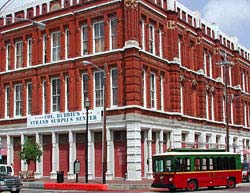
Col. Bubbie's Strand Surplus Store Galveston, Texas |
Colonel Bubbie's Strand Surplus Store in Galveston, TX
Colonel Bubbie's Strand Surplus Store in Galveston, Texas was another on the 'Old Time, huge inventory, stocks everything' surplus stores. I went there while in town for the Galveston MVCC (MVPA) convention. I was there for many hours and did ferret out some treasures, only to be disappointed when after doing all the work to find them, the Col. wanted about 2x the going rate from high end dealers like Hayes O. Needless to say it all went back into the catacombs. From reading their not too favorable reviews on Yahoo Travel, it doesn't look like anything has changed there. Brian, I used to like to go to Col. Bubbies when I would go down to Galveston. Got some nice WWII things back in the early 90's. Wonder if it made it through the hurricane. - Chantel Tennyson |
|||
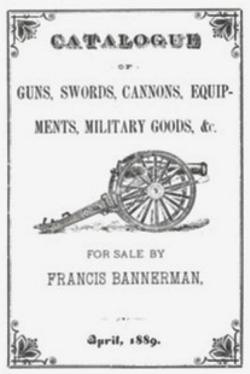
- Coming Soon -
http://american-business.org/2798-war-surplus.html |
BANNERMAN's
Bannerman's is most likely the greatest army surplus venture there will ever be. Francis (Frank) Bannerman VI - The Father of the Army-Navy StoreThe patriarch of Bannermans family business and the builder of Bannerman's Castle, Frank Bannerman VI, was a Scottish patriot, very proud of his descent from one of the few Macdonald's to survive the massacre at Glencoe in 1692. During the 1690's, the King of England demanded allegiance from the Scottish clans. Legend has it that the Macdonald clan was slow to give the British their oath of loyalty. Acting on behalf of the Crown, a rival clan, the Campbells, slaughtered all Macdonald males ages 12-70. One escaped to the hills with the clan banner -- and from that day on, his family name was Bannerman. (3) Bannerman's CataloguesBannerman Catalogs have been of great interest to Militaria and gun collectors, as well as sportsmen for the past 125 years. |
Military Vehicle Surplus Sales - Yards & Dealers
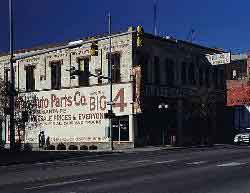 Pueblo
Auto Parts - Pueblo, Colorado WAS full of NOS WWII Army Surplus Jeep parts Pueblo
Auto Parts - Pueblo, Colorado WAS full of NOS WWII Army Surplus Jeep parts
|
PUEBLO AUTO PARTS a.k.a.
BIG
4 AUTO PARTS in Pueblo, Colorado. People don't believe me when
I try to describe it to them. This was the only place like it I have ever
been. It was unique and if you never saw it for yourself, you won't believe
that a place like that existed. I have made at least 3 trips there with
a year or so between visits. They were 2-day visits. They had to be to
do it right. There was just too much stuff to see and dig & crawl
and climb through. Pigeon poop being a large part of the contents of the
building. The 122 year old building was a multi-story hotel built before
the turn of the century. Add to that the 3 level basement. Everything was
full of parts, even the elevator shafts. Everything was full of shelves,
crates, piles, boxes, stacks, bundles, sacks, etc. of antique (20's, 30's,
40's, 50's) auto & truck parts - mostly military vehicle parts. The
hotel room doors were removed for easier access. The rooms were full of
shelves. Rows & rows of shelves. The problem was that the shelves had
all fallen forward onto the shelf unit in front of it. It was like a big
stack of dominoes in the process of falling. The contents of every
downward facing shelf was piled high on the floor in front of it, while
all the up facing shelves were jumbled and mixed up and hard to get at.
So imagine a 3 ft pile of stuff at the base of EACH shelf unit, where you
had to crawl under the tilted shelf unit to try to get to the bottom of
the pile. You had to move the pile to see what was on the bottom shelf,
because the bottom shelf tilted the least so it didn't travel far. Most
people took one look and said forget it! The more adventurous dove right
it, but I would guess that many never got to the bottom of the piles.
Now visualize room after room after room like this, then go up another
story and find another floor like the one that just took 3 hours to go
through. Ok, sounds like fun doesn't it? Well the bad news is that
many windows are broken out on every floor, and pigeons by the score have
decided to bury all the auto parts in poop & feathers. Now it's not
so fun anymore. There were spider webs, and dust piles the size of
small rats. I'm pretty sure they weren't rats as they didn't move.
Lighting was also an issue. There might be 1 single incandescent bulb in
the center hallway and that was it. There you are 40 feet away in another
room wondering if maybe that isn't a dust pile after all and sometimes
it wasn't. Sometimes it was a rat, and sometimes he had friends.
I am not about to let some stupid rats come between me and those NOS Ford
GPA mufflers in the corner. When I emerged hours later, I didn't look human.
I think this is the filthiest I have ever been. The 1st trip was a success.
I spent hundreds of dollars and was happy as a clam. Well as happy as any
filthy, stinky, pigeon poop covered clam with a truck full of NOS WWII
jeep parts could be.
The 2nd time I went to Pueblo Auto Parts I went far better prepared. The first time I went not believing the stories I had heard. The first time I went unprepared. I didn't make that mistake again. I was going in for the long haul and going in loaded for bear. It was me against the pigeons and their poop, the spiders and their irritating webs, the dust bunnies/dust rats, and the various dirt, trash, and broken glass. I came with several sets of gloves, extra batteries, flashlights, backpack & canvas bags, dust mask, a headset walkie talkie, and 2 bottles of water in a butt pack. I ate before I went in. I was working my way through crawl spaces where gravity could be my undoing if a shelf unit decided to give way and finish the trip it started towards the ground. CRIKEY! <tipping hat to Steve Irwin> I loved it!. I spent 8 hours in there. They kicked me out at closing. I got a hotel room down the road because I wasn't done yet. I loved it even more the 2nd day! Hundreds more $ spent. Ohh, but they were deals. A couple of years later I was back again for more. I am glad I did it and I am sorry I can't ever go back there to do it again. It's gone! ;-( Downtown fixture Big Four Auto Parts waits for progress to bring a buyer. (The Pueblo Chieftain) Dec. 20, 1995 The Big Four auto parts building looks every bit its 110 years; and its windows are full of shiny auto parts.Pueblo, Colo., Auto Parts Store Closes after 70 Years in Business. (Knight Ridder/Tribune) Nov. 30, 2000 Nov. 30 -- Decades worth of inventory at the Big 4 Auto Parts store Downtown on Santa Fe Avenue will be auctioned Saturday. The sale, beginning at 10 a.m., marks another step leading to the demolition of most of the buildings on the west side of the 200 block of North Sante Fe Avenue to make way for parking for the Sangre de Cristo Arts Center. <Link>Liquidation Auction at Landmark Pueblo, Colo., Auto Parts Store Draws Crowd. (Knight Ridder/Tribune) Dec. 4, 2000 Dec. 4 -- Charles Miller was like a kid in a toy store when he walked into the Big 4 Auto Parts store Saturday morning. "This is awesome," said Miller of Denver as he perused box after box in aisle after aisle of the 70-year-old auto parts store. "I haven't been this excited about stuff since I was a kid," he said. "I don't plan to leave here without at least a couple boxes of stuff." Miller joined hundreds of other auto part, antique or simply nostalgia lovers who gathered at the Big 4 store at 201 N. Santa Fe for a gigantic one-day liquidation auction. Everything ... <Link> *If anyone has photos of Pueblo Auto Parts or other surplus yards I mention - please email me so I can add them. THANKS! |
Brian's Military Jeeps of
WWII
Surplus WWII Jeep parts &
Accessories - World War Two US GI Accouterments & AAF Gear
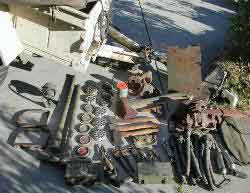 MA,
T-1 Air Compressor, other rare Willys, Ford, and Bantam Jeep parts MA,
T-1 Air Compressor, other rare Willys, Ford, and Bantam Jeep parts
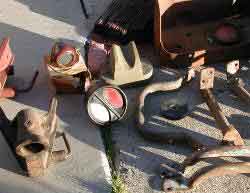 Willys
MBT Jeep trailer, "F" Ford GPW, and Ford GP Prototype Parts Willys
MBT Jeep trailer, "F" Ford GPW, and Ford GP Prototype Parts
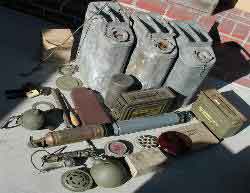 Decontaminiator,
Early Galvanized Jerry cans, and other rare WW2 Jeep parts Decontaminiator,
Early Galvanized Jerry cans, and other rare WW2 Jeep parts
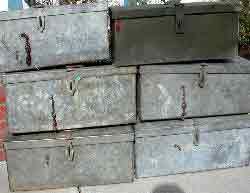 WWII
dated Jeep mechanics tool boxes packed full of NOS MB/GPW jeep parts WWII
dated Jeep mechanics tool boxes packed full of NOS MB/GPW jeep parts
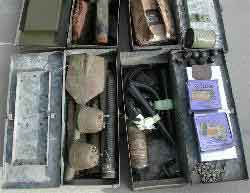
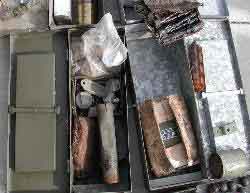
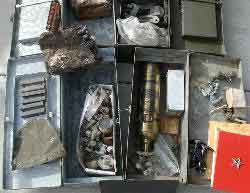
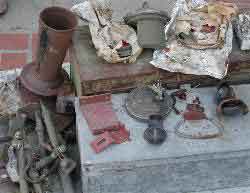
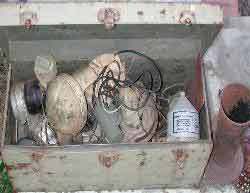 Fuel
Filters, B/O marker lights, and other rare W.W.II collectibles. Fuel
Filters, B/O marker lights, and other rare W.W.II collectibles.
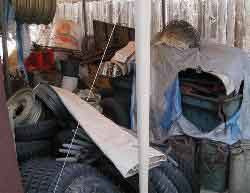 World
War Two trailer full of Gas Cans, Combat Rims, and 6:00-16 NDT tires. World
War Two trailer full of Gas Cans, Combat Rims, and 6:00-16 NDT tires. |
In 1983 I purchased my 1st WWII Jeep. A running and driveable 1942
Willys MB. It was missing everything Military though. I searched
high & low for the parts I was missing. Although I was attending college,
I tried to buy extra WW2 jeep parts whenever I found a good deal on them.
I started trading extra parts through the mail to get supplies of trading
parts that no one had in the local So. Calif. area. Real Estate in
Orange County, CA is too expensive to store inexpensive things like 30
cent piston rings. It only makes sense to store the really valuable (and
hopefully small) Jeep parts. I always liked all the accessories and goodies
that WWII jeeps either came with or had Modification Kits for, so this
worked out well for me. I bought up all I could find of the things that
met those prerequisites for size, value, and rarity. Years later when I
decided to take advantage of a job opportunity with several publishing
companies, it meant I wouldn't be around home very much. This traveling
salesman job made it too difficult to sell parts, but it didn't stop me
from buying as much as I could and stocking it away for a time when I would
be working close to home again. Now the walls are busting with stuff.
It's packed full and overflowing everywhere. I just started opening
up boxes, crates, and barrels of WWII Jeep Parts & accessories that
I had locked up & stored for between 10-20 years. The majority are
NOS. I am now cleaning, degreasing, in in some instances glass beading
& painting these rare parts. Some finds so far are MA headlight
brackets, Slatgrill Brass Windshield Clamps, Decontaminators, 1st Aid kits,
Red Stimsonite reflectors, Spare Parks Kit Firestone Spark Plugs, Machine
Gun Mount pieces, Ford & Willys Pintle Hooks, Ford Ignition Switches,
Gearshift Knobs, Handcrank Clamps, Grease Gun Adapters, Sirens, Harley
Davidson Blackout Lights, WWII Jeep Axes, WWII GI Hand Axes, WWII Slatgrill
Shovels, MB/GPW shovels, Entrenching Shovels, WWII Vehicle Equipment Pick
Ax, GI Entrenching Picks, WWII General License Plates, Jeep Windshield
Defroster Kits, Ford & Corcoran Brown BO Lights & Guards. There
are some photographs posted to the sides and below of what it looked like
to open just some of these boxes and crates. Pristine pieces will be sold
AS IS in NOS condition. In cases where something was NOS but had
some flaw such as rust stains or badly flaking paint, then my goal is to
make these parts be ready to install in a top notch restoration. To have
them be in the best condition for sale, they
might be degreased
(cosmoline removed), if there is storage wear
or any spots of surface rust, the parts might be stripped chemically,
then touched up with a glass bead machine for maximum rust eradication
(if any) and for best paint adhesion. Parts would then be primed and painted
and ready for sale.
This is pretty much going to be it. I don't foresee finding any more warehouses or hordes of WWII MB / GPW Jeep parts. I haven't seen those since 1990. So out of the bundle of 12 Jeep Axes, I am keeping 4 for my jeeps, leaving 8 for sale. There might be another Ax that turns up, but all the jeep parts were pretty well organized when I put them all away years ago. So when those 8 Axes are gone, that's it. I will post as much info on each item when I offer it for sale. As much as I would love to chat & email back in forth and answer questions in great detail, I can't. If I do, nothing gets done. Nothing gets opened, degreased, glass beaded, painted, photographed, cropped & uploaded. No ads get written, auctions run, items boxed up, & taken to the shipper. It's a one man show here. Since I will be in the shop wearing various hoods, gloves, working with paint, chemicals, air tools, etc., I won't be anywhere near a computer to answer questions or look at your 'want lists'. Sorry. I spend too much time on the internet as it is and I need to cut way back as it seems I never get the jeep jobs started let alone finished. Also, re: wants lists. I am trying to get all similar parts ready at the same time to the best of my ability. All the shovels, all the WWII Jerry can spouts etc. Usually the parts were put in as groups originally, so they should be coming out in groups. I don’t have a map to locate specific parts; I just open the boxes as I work my way farther & farther back. Then I take the boxes down to the shop for clean up and preparation for sale. Last thing is: I don't know who I should sell the parts too. Do I sell
to the guy who mailed me a letter 8 years ago looking for something because
he's been waiting the longest?; The guy from the local jeep club because
I've seen him at the meetings for 15 years; The guy who is a total white
glove museum grade restoration because I know he'll worship it?; The guy
who really uses his jeep because he drives the jeep weekly and wants it
to keep it running?; The new guy who lives 2 miles away and just
got his 1st WWII jeep because he's close?
Join
my email Notification List to find out immediately when (and what)
items are posted for sale. See the
sales flyer.
|
Cosmoline - What's that?
The military was very concerned that the spare parts being sent to overseas theaters arrive in new pristine condition after their months of ocean transit. The parts would be exposed to salt water, salt spray, high humidity, rain, possible oil and chemical spills, as well as rough handling and dirty conditions. The military went to great lengths to preserve their spare parts. The most common method of preserving parts was to coat the parts in cosmoline, and/or place them in a cardboard boxes and then coat the boxes with cosmoline and wax paper. Cosmoline is the trade name for a general class of rust preventatives, very similar to petroleum jelly in properties, appearance, and thickness. Cosmoline is the purified ointment like residue obtained from the distillation of petroleum oils. Chemically, cosmoline is a homogeneous mixture of oily and waxy long-chain, non-polar hydrocarbons. Cosmoline feels very waxy or oily and has a petroleum-like odor and taste. Cosmoline can be found in several colors and shades. It can range in color from white to yellow, light-amber, or green. Other times a nice light opaque brown, and still other times it is dark and black as coal. Cosmoline melts from 113–125 °F (45–52 °C), has a flash point of 365 °F (185 °C), and can differ in viscosity and shear strength. Besides military vehicle parts, another common use for cosmoline was in the storage and preservation of firearms. In fact it is used to preserve from very small to the very large items. In the past items as large as vehicles and even larger coastal artillery pieces have been preserved for future use with cosmoline. In the jeep realm, the older, long time collectors can remember needing a pocket knife to scrape off the thick cosmoline coatings so you could read the contents label when exploring the old truck surplus warehouses. You never really knew what you had found until you could scrape off enough layers to be able to read the label under all those layers. It was a dirty, filthy job, yet oh how I miss those days. It seems now everything is repro, or used. Very few items are still found 'In The Cosmoline'.
Rumor has it you can make Cosmoline yourself as follows;
1) get, mix & melt equal amounts of lanolin and petroleum jelly (large tub) in a double boiler.
2) Apply it warm.
Be aware it will harden like concrete and is hard to get off.You can still buy it outright as well;
"Cosmoline, rare item. New 10 Lb bricks new in cardboard boxes. Just heat in old pan until melted and dip your valuable parts in. I have found parts treated this way in old Surplus Yards that have been laying outside for 40 years and they are still like new. Works great for gun collectors also. $14.95 a brick"
Army Surplus WarehouseMidway sells a product they call Cosmoline: http://www.midwayusa.com/rewriteaproduct/267557
P.O. Box 1523
Idaho Falls, Idaho 83403
Phone: 208 529 4753
asw@armysurpluswarehouse.com
**UPDATE: It is now sold out: I recieved an email from Amber at ArmySurplusWarehouse, as follows:Hi,
I looked at you're website! Its very nice! I saw that you have one of our old items featured on you're website. We are out of stock and keep getting a lot of phone calls for the cosmoline. Sadly, it is a thing of the past for us, we can not buy it anymore.
Apparently there is a lot of people on you're site tho :)
Keep up the good work! Thank You!Brownell's has RIG rust preventive grease It may or may not be Cosmoline, but would probably work as well. http://www.brownells.com/aspx/NS/store/ProductDetail.aspx?p=10073
Perhaps instead of wanting to put on cosmoline, you want to get rid of it and remove it - if so, here is a good link on the topic.
Speaking of Army Surplus... What about those $50 Jeep in a Crate Stories?
| BACK TO
|
|||||
| Table
of
Contents |
Post
your Free
Classified Ads |
Link
to this
web site |
Navigation
Help |
||
![]()
![]()
Please don't pirate my pictures or text. Ask
my permission.
Copyright
© 1998-2012 Brian French. All Rights Reserved
Free counters provided by Andale.